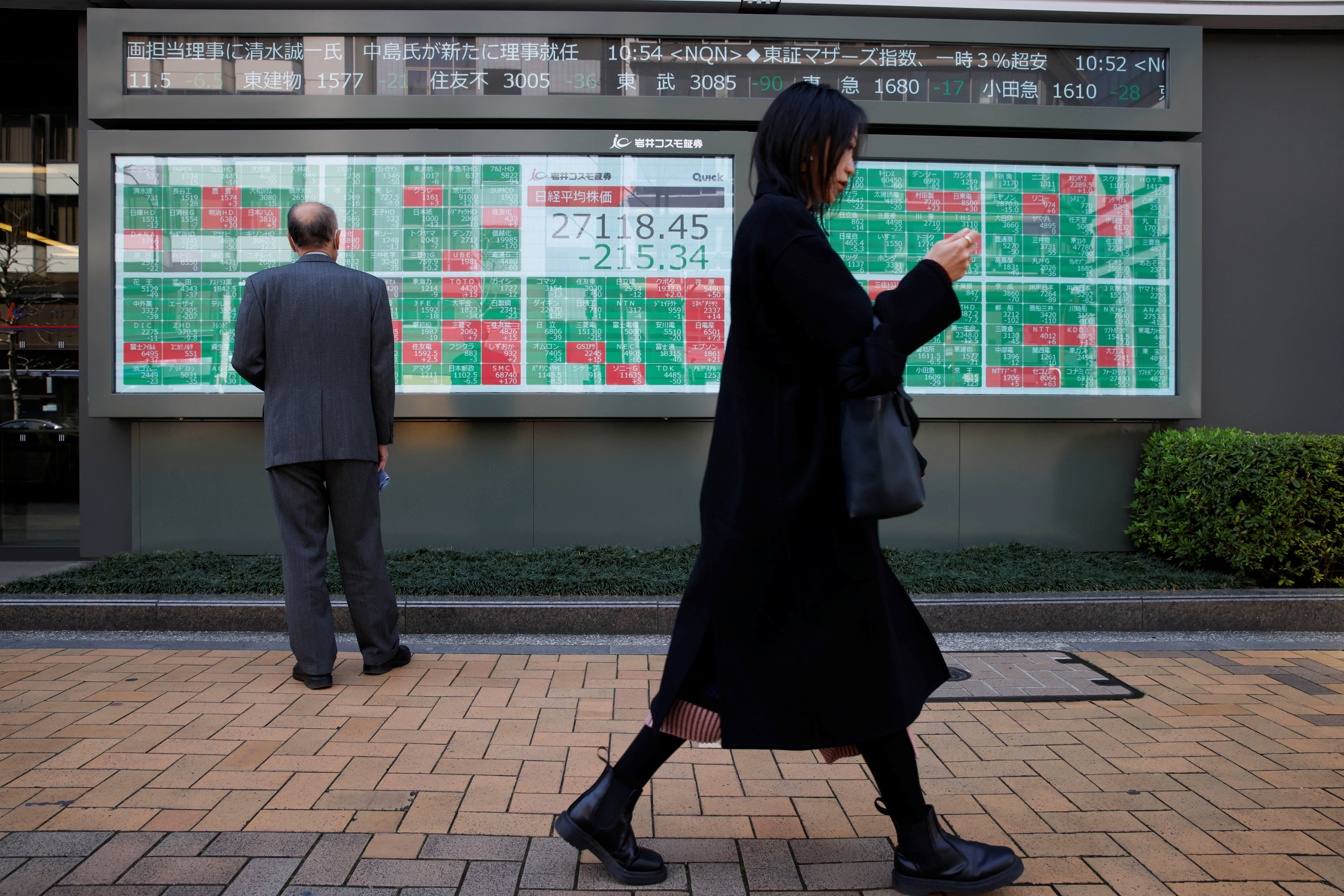A woman walks past a man examining an electronic board showing Japan’s Nikkei average and stock quotations outside a brokerage, in Tokyo, Japan, March 20, 2023. REUTERS/Androniki Christodoulou/File Photo Acquire Licensing Rights
SINGAPORE, Nov 15 (Reuters) – Asian stocks surged to two-month highs on Wednesday in anticipation of stimulus in China and an end to rate hikes in the United States, while the dollar nursed steep losses suffered in the wake of a benign U.S. inflation report.
MSCI’s broadest index of Asia-Pacific shares outside Japan (.MIAPJ0000PUS) was up 2.3% by the mid-session break in Hong Kong, hitting its highest since mid-September and on track for its largest daily gain since January.
The Hang Seng (.HSI) rose nearly 3%, breaking above its 50-day moving average, while Japan’s Nikkei (.N225) was up 2.3%.
Bond markets from Australia to South Korea marked their strongest gains since March, although rallies in Treasuries and in U.S. and European equity futures petered out into steady trade.
U.S. headline consumer prices were flat in October, against expectations for a 0.1% rise, data showed on Tuesday. Core CPI, at 0.2%, also came in below a forecast of 0.3%.
“I think the CPI number has just pushed the last person to cover their shorts,” Naka Matsuzawa, Nomura’s chief macro strategist, said on the phone from Tokyo.
He sees a “more complicated” process ahead, where stock market exuberance eventually collides with bond market expectations that an economic slowdown will drive rate cuts.
“The bond market is probably more vulnerable than equities,” he said.
Overnight, the Nasdaq (.IXIC) jumped 2.4% and the small-cap Russell 2000 index (.RUT) leapt 5%. The U.S. dollar slid 1.6% on the euro and 2% on the Australian and New Zealand dollars.
Interest rate futures swung to price in a rate cut as early as May, with a 30% chance it could come even sooner, in March. Two-year Treasury yields dropped 22 bps overnight and were mostly steady through Asia trade at 4.84%.
British inflation data, due at 0700 GMT, U.S. retail sales, due at 1330 GMT, and an expected morning meeting between U.S. President Joe Biden and his Chinese counterpart Xi Jinping in San Francisco are the next focus for financial markets.
BEIJING SUPPORT
Adding to markets’ cheer in Asia was strong industrial output and retail sales data in China and a report from Bloomberg News that China plans to provide 1 trillion yuan ($137 billion) of low-cost financing to boost the housing market.
Iron ore rallied to a 2-1/2 year high and copper rose to a three-week peak in Shanghai.
The mainland CSI300 index (.CSI300) rose 0.6%. The Hang Seng index of mainland property developers (.HSMPI) rose 4.3%.
China’s retail sales rose 7.6% in October, although that may have been flattered by the Golden Week holiday at the start of the month. Real estate remains in a deep funk, with investment in January-October down 9.3% year-on-year.
“It is clear that Beijing has been turning more proactive in recent weeks to help support the recovery,” HSBC economists said in a note to clients. “With ongoing uncertainties highlighted by the property sector, we think Beijing will continue to step up support through both fiscal and monetary means.”
A weaker dollar helped boost the yuan to a three-month high of 7.2356 per greenback. The euro , which surged through its 200-day moving average overnight, hovered at $1.0877, and sterling held sharp gains at $1.2491.
Data on Australian wages out on Wednesday showed high inflation was feeding into pay deals, although annual growth of 4% was still well below many other developed nations.
Japan’s economy, meanwhile, contracted in July-September, official data showed, leaving the yen unloved as the slowdown puts the brakes rate hike expectations there. The yen hit a 16-year low of 163.9 yen per euro and handed back some of Tuesday’s gains to trade at 150.68 per dollar .
Two-year Japanese government bonds managed their sharpest rally since April 2022, with the yield falling more than 3 bps to 0.055%.
Brent crude futures rose 0.4% or 31 cents a barrel to $82.78.
(This story has been refiled to correct the spelling of ‘Russell’ in paragraph 9)
Reporting by Tom Westbrook; Editing by Edmund Klamann
Our Standards: The Thomson Reuters Trust Principles.
Credit: Source link




